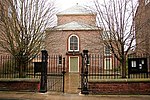Peaseholme House
Grade II* listed buildings in YorkHouses in North YorkshireNorth Yorkshire building and structure stubsUse British English from March 2017

Peaseholme House or Peasholme House is a Georgian building on St Saviour's Place, near Peasholme Green in York, England. It was built c. 1752 probably by John Carr for a carpenter named Richard Heworth. It is Grade II* listed.It has "strange rustication", with red brick in the front and orange brick at the back.
Excerpt from the Wikipedia article Peaseholme House (License: CC BY-SA 3.0, Authors, Images).Peaseholme House
St Saviours Place, York Layerthorpe
Geographical coordinates (GPS) Address Nearby Places Show on map
Geographical coordinates (GPS)
| Latitude | Longitude |
|---|---|
| N 53.9601 ° | E -1.0767 ° |
Address
St Saviours Place
St Saviours Place
YO1 7PJ York, Layerthorpe
England, United Kingdom
Open on Google Maps









